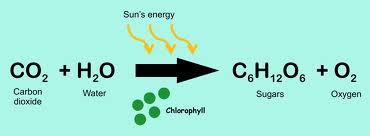554
Photosynthesis is a process used by plants and a few other organisms to make their own food by harnessing the energy from the sun’s light and converting it to chemical energy. The process of photosynthesis is dependent on a lot of factors and a change in any of these could actually prevent it from occurring normally, as we would like it. Major factors which could stop the process of photosynthesis include- absence of sunlight, carbon dioxide or water, since these are basic requirements for the process. While you might be aware that the process occurs in a small organelle inside the plant’s cells known as chloroplast, chlorophyll is an important pigment for the process. Any loss of this pigment due to genetic or biochemical factors would also prevent photosynthesis. Also, the end result is photosynthesis is the production of glucose. So, if a plant has enough glucose, there will be a halt in the process.
 |
|
Biochemstry of Photosynthesis.
Image Source: www.lifeadrfit.info
|
Of more interest is the optimum temperature range in which photosynthesis occurs- the upper limit of which is 40 degrees Centigrade. This limit assumes a lot of importance in today’s world because of the rising temperatures attributable to global warming. Plants are quite resilient and higher temperatures for a couple of days might not have deteriorating effects, but high temperatures for a few weeks is a different matter- plants would not be able to synthesize their own food and would perish. Even an accident such as oil spill can also prevent photosynthesis in marine plants by blocking sun light and contaminating the water. On the long term, a residue is left behind on the surface which forms tar mats which absorb sunlight and elevate the water temperature, again slowing photosynthesis.
So, what would happen if all these factors came together and eventually photosynthesis stopped? The answer is pretty simple and easy to guess. Through the process of photosynthesis, three important things happen- carbon dioxide from the atmosphere is absorbed by the plants to produce energy, oxygen is released as a by-product of this reaction, and this is the process by which all life on earth obtains its energy. So, if photosynthesis stopped, it would essentially mean the end of all life on earth, the glucose we consume to sustain our life will no longer be available to us, and secondly because air would become rich in carbon dioxide and deficient in oxygen, leaving us unable to breathe. But this is not exactly how the story would unfold.
For a long time it was believed that only plants, algae and a few bacteria were capable of photosynthesis, but that is part of the truth. Recently, scientists have found evidence that some animals also have the ability to synthesize energy using sunlight. The first such animal to be discovered was the sea slug or Elysia chlorotica which integrated molecules of chlorophyll from the algae it ate! Scientists have also found a vertebrate- the spotted salamander, which has algal symbionts in its cells itself, somewhat like the slug.
Now, using biomimetics, i.e. mimicing biologically available systems, scientists are now developing efficient methods of utilising sun’s energy to generate glucose and even fuels. This is the process of ‘artificial photosynthesis’. Artificial photosynthesis is a truly revolutionary idea. Basically this system is able to harvest sunlight and split water molecules, just like plants, but in this case it releases hydrogen too, instead of just oxygen. Efforts are being made to streamline this process to isolate hydrogen and oxygen separately, where hydrogen will be used a fuel and oxygen can be released in the atmosphere as and when required. Also, instead of producing glucose alone, scientists are using modified systems to produce methonal or butanol that can also be used as fuel for vehicles and will work out cheaper than gasoline.
While we have not yet perfected this technique, there have been many important advances in the last 10 years- especially pertaining to catalysts that can be used in place of chlorophyll. We have already developed photovoltaic cells, but these are not very efficient. Therefore, photo catalytic cells are our new hope for the future. Once perfected, this system will redefine the availability of energy and fuel in our world. Probably ten years from now, you will see photo catalytic cells lined up on both sides of the expressway you take.
Related articles
- Photosynthesis (daniel1lewis95.wordpress.com)
- Professor identifies proton pathway in photosynthesis (rdmag.com)
- Algae Apartments in Hamburg Use Photosynthesis for Power (itsabeautifulearth.com)




2 comments
Useful information shared..Iam very happy to read this article..thanks for giving us nice info.Fantastic walk-through. I appreciate this post.
Glad you liked our post 🙂